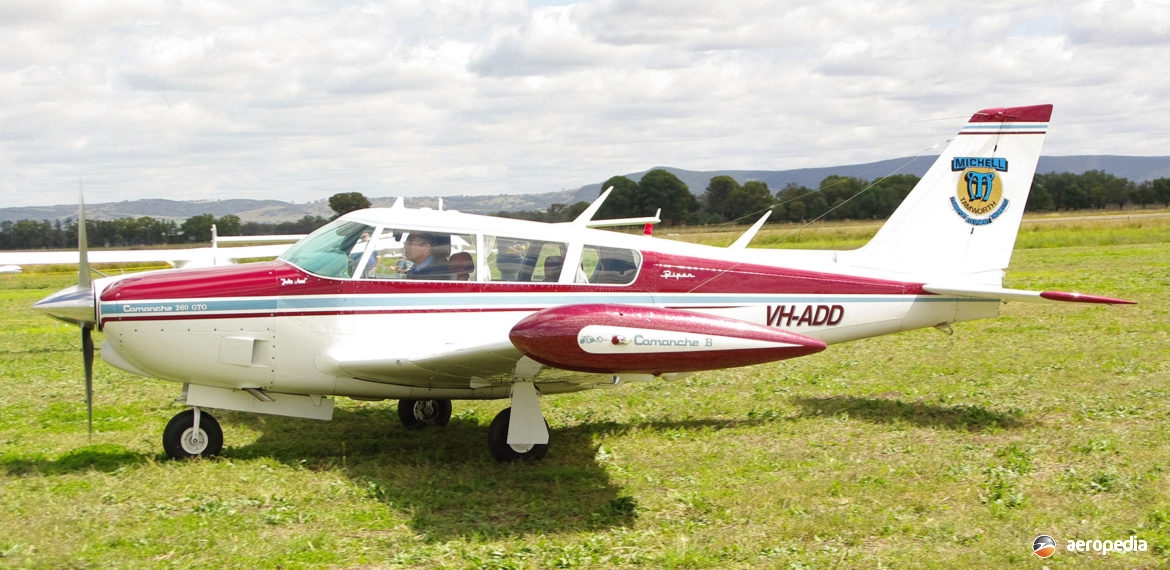Photograph:
Piper PA-24-260 Comanche VH-ADD (c/n 24-4401) at Cowra, NSW in March 2012 (David C Eyre)
Country of origin:
United States of America
Description:
Light touring cabin monoplane
Power Plant:
One 194 kw (260 hp) Lycoming IO-540 six-cylinder turbocharged horizontally-opposed air-cooled engine
Specifications:
- Wingspan: 10.97 m (35 ft 11¾ in)
- Length: 7.71 m (25 ft 3½ in)
- Height: 2.27 m (7 ft 5½ in)
- Wing area: 16.54 m² (178 sq ft)
- Max speed at sea level: 389 km/h (242 mph)
- Cruising speed at 75% power: 367 km/h (228 mph)
- Cruising speed at 55% power at 7,620 m (25,000 ft): 336 km/h (209 mph)
- Stalling speed undercarriage and flaps down: 108 km/h (67 mph)
- Initial rate of climb: 402 m/min (1,320 ft/min)
- Service ceiling: 7,620 m (25,000 ft)
- Range with standard fuel at max cruise: 1,802 km 1,120 miles
- Range at economical cruise with 45 mins reserve, optional fuel tanks: 2,140 km (1,330 miles)
- Empty weight: 859 kg (1,894 lb)
- Useful load: 592 kg (1,306 lb)
- Loaded weight: 1,452 kg (3,200 lb)
History:
Designed as a single-engine, high-performance executive aircraft, the Comanche was developed and sold in large numbers throughout the world and, when production concluded in the 1980s when floods destroyed the production line at Lock Haven in Pennsylvania, some 4,856 examples had been completed, comprising 1,143 Model 180s, 2,537 Model 250s, 1,028 Model 260s and 260T, two prototypes and 146 Model 400s. It has been very popular in this region, with 73 examples appearing on the Australian register and four on the New Zealand register.
The prototype of the series was flown for the first time on 24 May 1956, followed by the first production machine on 21 October 1957. It was aimed at the market for business travel, at night and in instrument conditions; a fast, efficient aeroplane. It had a low-wing, electric-retractable undercarriage, constant-speed propeller with a roomy cabin and was well-equipped to compete against the Beech Bonanza.
After certification, the first model to be marketed was the PA-24-180. All models which sold during the type’s production life had the engine power appended to the Piper model number to indicate the type of engine installed. In 1958 a more powerful version was introduced as the PA-24-250 with the Lycoming O-540 six-cylinder engine in place of the four-cylinder unit.
Piper also offered a number of packages with the series: in the Custom it included various avionics packages, basic autopilot etc; in the Executive electric trim and upgraded autopilot; in the Sportsman package upgraded interiors, including leather seats; and in the Professional IFR avionics and autopilot.
In 1964 the model PA-24-250 was followed by the PA-24-260 with improved sound-proofing in the cabin, a modified undercarriage, and either the Lycoming O-540-E or IO-540-D engines, depending on customer preference. In 1965 the PA-24-260 was updated and refined, having extended window area, and seating for up to six persons. This model became known as the PA-24-260 B and had a longer propeller spinner, a slightly longer fuselage for the extra seats, a third set of windows, thicker glass, improved soundproofing and increased gross weight by 91 kg (200 lb) to 1,406 kg (3,100 lb).
It was further refined in 1969 in the PA-24-260 Comanche C, this having the 154 kw (260 hp) turbocharged and fuel-injected IO-540-R1A5 six-cylinder engine driving a two-blade constant speed propeller. This model had the propeller shaft on the Lycoming IO-540-N1AS engine extended to permit installation of a re-designed engine cowling similar to that on the Twin Comanche; and it had an increase in baggage capacity by 23 kg (50 lb) to 113 kg (250 lb). Final variant was the Turbo Comanche 260 C fitted at the Piper plant with two Rajay Industries turbochargers, one on each exhaust, the pilot controlling boost with a manually-operated waste-gate. However, this model was not popular and only 28 were delivered between 1970 and 1972.
In the United States LoPresti Speed Merchants has made modifications to a number of Comanches in order to reduce drag, increasing speed by up to 41 km/h (25 mph). British Aviatrix Sheila Scott used a number of Comanches for some of her record breaking flights. In PA-24-260 B G-ATOY in May 1966 she flew around the world in 33 days, with stop-overs in 18 countries, covering 46,116 km (28,656 miles), and set eight inter-city records in class C-1c [aircraft in the 1,750 kg to 3,000 kg gross weight category], one of which was the London to Sydney record set in 1938 in a DH.88 Comet by Messrs Clouston and Ricketts of 80 hrs 56 mins; and London to Auckland.
In 1967 a variant of the PA-24 was modified by Edward Swearingen to have a pressurised cabin and this became the PA-33. However, it was destroyed in a taxiing accident and was not put into production. Wing-tip fuel tanks became available from Brittain Industries with a capacity of 113 litres (25 Imp gals), the useful load with aircraft so equipped being lifted to 1,361 kg (3,000 lb).
The Comanche series over the years has held a wide range of FAI homulgated records, the first of these being that by ferry pilot Max Conrad in a Comanche 250 in June 1959 when he flew non-stop from Casablanca in Morocco to Los Angeles, California, a distance of 12,340 km (7,668 miles). At the time of take-off the aircraft was 907 kg (2,000 lb) over its gross weight limit. One Comanche (N8041P) is known to have been fitted with an AiResearch TPE-331 turboprop of 429 kw (575 hp) and on 31 May 1968, flown by Jack Womack at Phoenix, Arizona, it set a record for Sub-Class C-1c landplanes of an altitude without payload of 12,972 metres (42,559 ft).

